SEO Analysis – A Professional’s Guide
Join the 1,000+ brands that trust us for their link building.
Let’s talk about why SEO analysis is so important and how it’s the cornerstone of improving a website’s ranking and organic traffic. Although great SEO is a skill that takes years of practice and strategy testing, simply covering the basics of SEO analysis will go a long way in benefiting the overall performance of your web pages.
SEO is fundamentally about increasing visibility and traffic by improving search engine rankings. There are many factors to analyze that influence these strategic outcomes, and this analysis is part of the process of refining strategies.
SEO is a mixture of art and science. Some SEOs take an analytically rigorous approach to developing strategies while combining that careful analysis with their intuitive grasp of trends and “what works”, to gain a competitive edge.
While some digital marketers only decide if their efforts have paid off after they’ve tested their results against a set of objective guidelines, others just want to do the bare minimum to rank a web page.
For anyone starting out, this simple guide is going to give you a professional, objective overview of SEO analysis. We’re going to teach you what works for us and what tools we use to accomplish our goals.
The Benefits of Analyzing a Website’s SEO
In a nutshell, SEO analysis is the process of finding opportunities to improve the ranking potential and organic traffic of a website.
Analyzing a website’s SEO basically involves evaluating on-page and off-page factors. You’re either trying to discover ideas to rank new content for target keywords, or trying to improve/optimize existing content and web pages through site auditing and backlinks analysis.
It’s important to continuously improve a site’s SEO to increase its rankings, maintain its current position, and keep up with the competition (that may be looking at the same things you are).
SEO analysis is not only about discovering and fixing flaws in a website through comprehensive auditing but also about identifying which aspects of existing strategies need refinement and where to apply new strategies. In other words, SEO analysis enables you to maintain your current performance while making informed, strategic decisions for improvement.
You should perform SEO analysis through a framework of satisfying search engine bots and algorithmic updates. Because constant algorithmic changes from Google can affect your site’s ranking, site auditing helps your site stay up-to-date and maintain (or retrieve) its position.
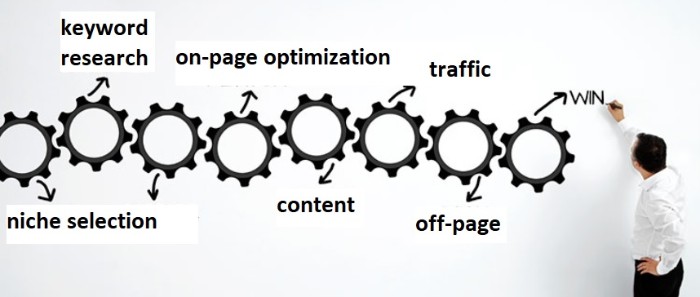
SEO analysis is also important for consistently delivering unique and valuable content. It allows you to identify profitable niches topics, choose the right keywords, and analyze your direct competition.
The benefits of analyzing a site’s SEO cannot be overstated. You won’t succeed in a competitive environment without doing some analysis. Here are some of the main benefits of analysis:
- Make informed decisions instead of wasting time/money
- Find opportunities to rank higher
- Increase visibility and expand your reach
- Drive more organic traffic to your pages
- Discover niches to capitalize on
- Publish great content
- Satisfy Google bots
How To Do An In-Depth SEO Analysis
Most SEO analysis can be covered by looking at how a site’s already performing in the SERPs, improving its on-page factors, and looking at its backlink profile (and other off-page factors) to make sure everything is optimized and nothing is missing or low-quality.
Remember, you’re typically trying to rank new content or improve existing content.
On-page factors include activities like keyword research, content analysis, onsite optimization, keyword positioning, and internal links.
Off-page factors include activities like evaluating external backlinks, competitive analysis, fixing broken links, updating directories and citations, link building, and content distribution/promotion.
Keyword research / content analysis
Keyword research should be performed at the beginning of trying to rank for new content.
You’re basically trying to find the top keywords (or less competitive keywords) for a given niche while making sure they’ll remain relevant to your content/topic, can generate decent traffic from your target audience, and aren’t so competitive that the effort/risk doesn’t justify the reward.
Targeting medium-tail keywords is a good idea when starting out as they give you a nice balance of difficulty and profitability. It’s best practice to choose one target keyword per content piece that’s supported by related keywords.
Content is very important to SEO. Basic content analysis for existing web pages is about making sure the content is original, relevant, engaging, and of the highest quality possible.
Remove any duplicate content. Correct any spelling or grammatical mistakes. Make sure to optimize keyword positioning and on-page factors. Learn how to write an effective piece of content from our article on guest blogging best practices.

Check the site’s search visibility / traffic
Get a general performance overview of a website by checking its search visibility and organic traffic.
Obviously, you want to know how a site is ranking in the Google SERPs. You can use tools (mentioned later in this article) that will assist you with visibility management and show you organic traffic/performance over time.
You should get an overview of how all your web pages are performing to prioritize improvement strategies. Of course, you can check out the competition too.
The “site: URL” search operator is useful for discovering how many of a domain’s pages are indexed by Google.
If you don’t have access to premium tools yet, you can manually check the SERPs for related content/articles.
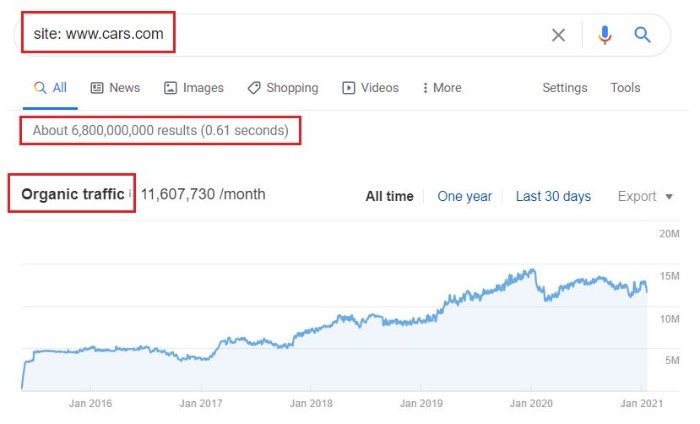
Look at the site’s on-page factors
On-page optimization refers to making changes to the content, source code, site structure, settings, and page hierarchy of a website to increase performance and communicate what it’s all about to search engines/users in order to improve its rankings and traffic in the SERPs.
It’s basically half the entire equation of SEO analysis for ranking in the search results (the other being off-page factors). It’s also related to content analysis, as the goal is to publish relevant, high-quality content that’s optimized for specific keywords.
A simpler way to describe on-page is that it’s all about optimizing your content, layout, and design. It includes important elements like keyword positioning, creating internal links and URL structure, title tags, and meta descriptions.
Some powerful tools to help with on-page are Surfer SEO, Screaming Frog, and WordPress plugins like Yoast SEO.
It’s much easier than it sounds, so check out our on page SEO guide.
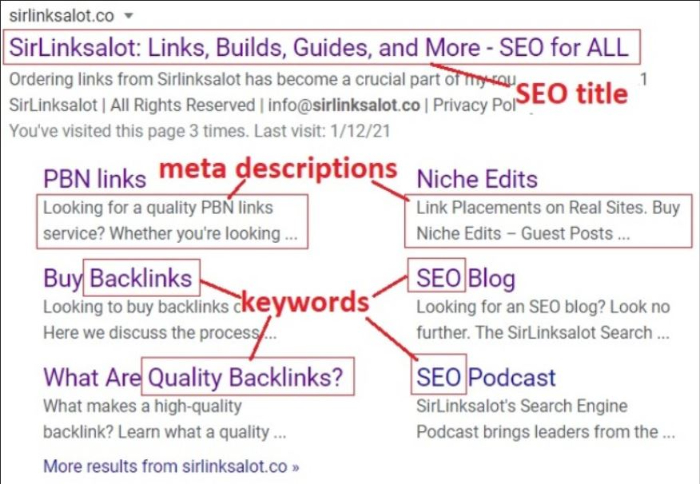
Evaluate the site’s backlink profile
Backlinks analysis and external link building are related to off-page SEO analysis. Off-page factors are related to activities performed outside of a website to increase search rankings.
These activities include content marketing/distribution, guest blogging, acquiring authority backlinks, creating pillow links, updating directories/social profiles, fixing broken links, finding opportunities, building relationships, outreach etc.
A site’s backlink profile has a substantial influence on ranking performance over time. The ultimate goal is to build a diverse and natural link profile made up of authoritative, relevant, and high-quality backlinks.
It’s important to analyze a site’s backlink profile to make sure it’s not receiving too many low-quality links like spam or negative SEO attacks.
Simply put, it just helps to understand who is linking to your website, and your competitors’ sites, when the goal is to rank in target niches.
This type of analysis is only possible with some of the powerful tools described later in this article. You can also learn more about the benefits of link building.
Now let’s briefly go over a couple of useful tools for on-page analysis: Surfer SEO and Screaming Frog.
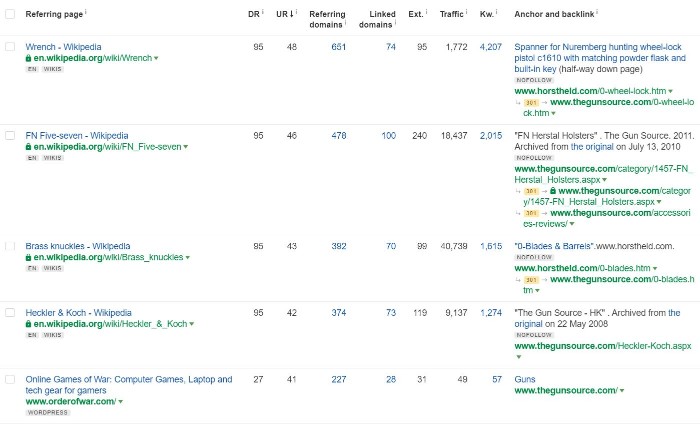
Using Surfer SEO for keyword research / content optimization
Surfer SEO is a data-driven tool for optimizing pages and writing new content. It’s an easy-to-use content discovery tool that enables you to scan and analyze a target SERP for on-page signals/ranking factors, top keywords, and content insights.
This information allows you to create an outline for writing optimized content that draws on useful data points from the top-performing pages in a SERP. Surfer SEO also improves the overall content management process.
Furthermore, it has a Keyword Research feature that gives you overlapping SERPs and ideas for how to get even more traction out of your content.

Using Screaming Frog for SEO audit
The Screaming Frog SEO Spider Tool is an industry-leading web crawler used for technical SEO website audits. This tool is very powerful when you need to analyze hundreds of sites, extract their data, and audit them for common SEO issues.
It allows you to discover issues that need improvement/optimization like broken links, temporary/permanent redirects, page titles and metadata, duplicate content, and site architecture (some of these features are available in a Free version).
Although you can definitely perform your own free SEO audit, an analysis tool like Screaming Frog is very handy when you have many complex websites that require regular auditing and you don’t have the resources or knowledge to do so.
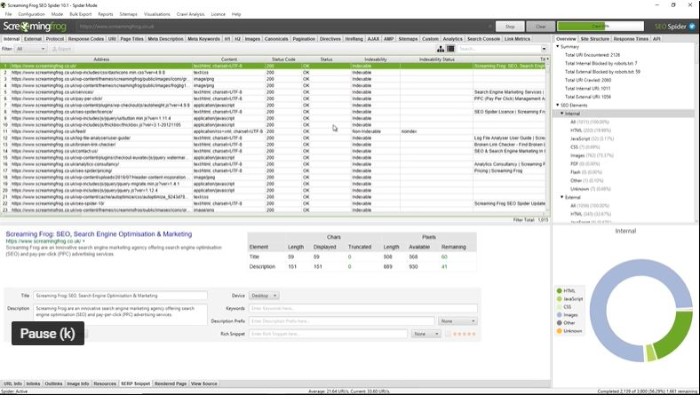
Use Tools For Analyzing Off-Page Factors
So we’ve discussed how off-page analysis/optimization is basically half the process of ranking in the SERPs, and what factors make up the core elements of off-page analysis.
However, good off-page analysis is only possible when you utilize specialized SEO tools like these:
Ahrefs
Ahrefs is a popular all-in-one SEO toolset for backlinks analysis, site exploration, content discovery, auditing, and performance tracking.
You can do practically all of your backlinks evaluation with Ahrefs. Analyzing your organic traffic and overall site performance is really easy with Ahrefs too. It has the biggest live index of backlinks of any tool.
Ahrefs is great for analyzing your competitors’ backlink profiles as well. The tool also has useful features for finding keywords and content gap analysis.
Check out our guide to using Ahrefs if you decide to start out with this powerful tool and learn how to perform deep analysis of websites.

SEMRush
SEMRush is another all-in-one search engine optimization platform for online visibility management, competitor research, content marketing, PPC, and social media marketing.
It features an insightful dashboard that provides SEO intelligence data like comprehensive domain reports, changes in keywords and traffic, similarity comparisons, and paid ads metrics, all through a smooth workflow design.
You can also perform keyword research, site audits, and on-page SEO analysis. SEMRush offers a complete solution for competitive researchers, digital agencies, small e-commerce stores, or large enterprises.

Majestic
Majestic is a focused digital marketing analysis tool that specializes in backlink analysis/reporting and link building. It excels at providing pure backlink data from two massive indexes (Fresh and Historic).
With Majestic you have a powerful investigation tool for checking backlinks as well as site exploration capabilities by filtering metrics, tracking and comparing sites, and analyzing/auditing backlink profiles.
Majestic also offers SEO browser plug-ins for advanced data access and on-demand analysis, and an API for loading data onto in-house applications.

Moz Pro
Moz Pro is an all-in-one SEO tool for tracking rankings, crawling/auditing websites, on-page optimization, finding link building opportunities, and understanding your visitors.
Its five core features include keyword research, performance tracking, website crawling, on-page SEO, and backlink research.
Moz Pro also provides customized, shareable reports that help with efforts to improve visibility and increase organic traffic.

Final Thoughts
We hope that this professional guide has given you a solid understanding of how to perform the core functions of SEO analysis for ranking and improving sites.
SEO analysis falls under two broad categories: on-page and off-page. Both are equally important for performing well in the Google search engine results pages over time. On-page is about optimizing your content and telling search engines and users what your website is about. Off-page is about external factors like link building and content promotion.
You’re going to typically perform SEO analysis on existing web pages to find areas of improvement (maybe your bounce rate is too high) or during the beginning of a content development strategy to rank for specific keywords in a niche.
Remember that anything you look for on your website can and should be done for your direct competition as well.
Contributing Author: Brian Kihneman
 Article by:
Article by:
Nicholas Altimore
Hey I'm Nick, the Founder/Director here at SirLinksalot. I have a passion for building online businesses and taking websites to the next level with the help of my amazing link building team.
 Questions or Comments?
Questions or Comments?
We are active in our Facebook Group seven days a week and would love to hear from you. Ask us questions, learn from other group members, and share your knowledge.
Related Posts
Ready To Start Building Your Rankings?
Your link building journey to the top of Google starts today!
Apply for Managed Link Building to get a free analysis and game plan, or order backlinks a la carte.
Link building services that work.


